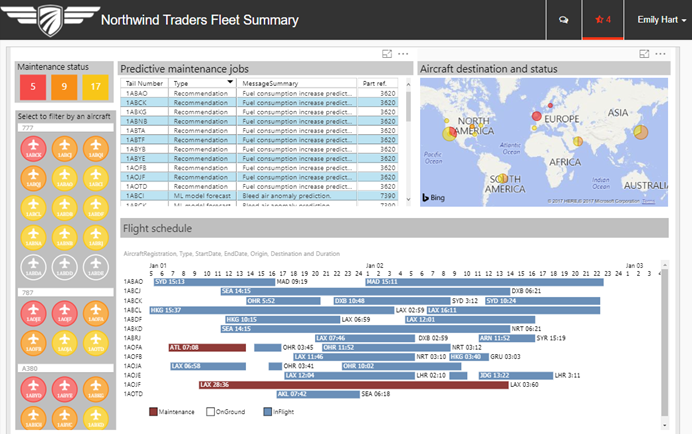Prologika Newsletter Winter 2017
Sharing Reports with External Users
Happy Holidays! I  hope you’re enjoying this special time of the year – time for sharing and giving. Speaking of sharing, how does your company share BI artifacts with your B2B or B2C partners? Do you still send Excel spreadsheets or embed canned SSRS reports? If so, Power BI offers a better sharing model and I’ll show you how in this letter. And about Power BI, I’m proud to announce that the third revision of my “Applied Power BI Book” should be out in a week or so. Thoroughly updated to reflect the latest of the ever-changing cloud world of Power BI and featuring 20% new content, this book is the self-study resource your organization needs to master Power BI.
hope you’re enjoying this special time of the year – time for sharing and giving. Speaking of sharing, how does your company share BI artifacts with your B2B or B2C partners? Do you still send Excel spreadsheets or embed canned SSRS reports? If so, Power BI offers a better sharing model and I’ll show you how in this letter. And about Power BI, I’m proud to announce that the third revision of my “Applied Power BI Book” should be out in a week or so. Thoroughly updated to reflect the latest of the ever-changing cloud world of Power BI and featuring 20% new content, this book is the self-study resource your organization needs to master Power BI.
Sharing in Power BI Service
Many organizations share reports with external users for Business to Business (B2B) or Business to Consumer (B2C) scenarios. If all you need is granting some external users access to some cool interactive reports and dashboards inside powerbi.com, you can do so by just sharing the content out using dashboard sharing or apps, as you do with internal users. But there are some special considerations though so read on.
Like using Power BI for internal use, external users need to be authenticated by a trusted authority. To authenticate external users, Power BI relies on Azure Active Directory (AAD). Therefore, the external organization and user need a record in AAD. If the user doesn’t have an AAD account, the user will be prompted to create one. Let’s say Elena from Adventure Works wants to grant Matthew from Prologika access to some Power BI content. Elena creates a workspace to host the external content and then she invites Matthew. To do so, she can simply share a dashboard or create an app, and then add Matthew’s email as a recipient. Matthew receives an invitation email with a link to the dashboard or app. Matthew clicks the link to access the content. Azure AAD verifies that Prologika and Matthew have records in AAD. If so, AAD will ask Matthew to sign in with his AAD credentials and grant him access to the shared Power BI content.
About cost, Power BI licensing for external users is not much different from licensing internal users. In a nutshell, the external user must have a Power BI Pro license to access Power BI content in the sharing tenant. This license can be acquired in one of three ways:
- The sharing organization is on Power BI Premium – If Adventure Works is on Power BI Premium and the sharing workspace is in a premium capacity, Elena can share content to external users, just like she can share content with internal Power BI Free users.
- The sharing organization assigns Power BI Pro licenses – Elena can assign one of her organization’s Power BI Pro licenses to Matthew.
- The external organization assigns Power BI Pro licenses – In this case, Matthew has a Power BI Pro license from the Prologika’s Power BI tenant. Matthew can bring in his license to all organizations that share content with Prologika.
Sharing with Power BI Embedded
Sharing in Power BI Service is simple, but it has some important drawbacks:
- Dependency on Azure Active Directory (AAD) – Every user must have an AAD account.
- Not adequate support for B2C – AAD is expected to support Live IDs soon, such as outlook.com emails, but you’d need to wait for other providers. Yet, many B2C apps allow external customers to authenticate with email addresses of their choice. UPDATE 3/11/2018: Power BI Service now supports sharing using personal emails.
- Per-user license – Despite that Power BI offers three licensing options for external users, every user must be covered by a Power BI Pro license.
- Read-only reports – Users are limited to read-only reports. They can change existing reports or create new reports.
Collectively known as Power BI Embedded, the Power BI embedded APIs can help your developers overcome these challenges in a cost-effective way. A developer can integrate any modern web-enabled app to embed Power BI dashboards, reports, and even natural questions, so that they appear as a part of your company’s offering (see the screenshot below), instead of redirecting the user to powerbi.com. Reports not only preserve their interactive features, but also users can edit them or create new reports from scratch (if your app lets them)!
There are two ways to acquire Power BI Embedded. If your organization is on Power BI Premium, you already have everything you need to embed content for both internal and external users (assuming a P plan as EM plans are more restrictive and for embedding only). Most smaller companies and Independent Software Vendors (ISVs) looking for embedding content to external users only, would gravitate toward the Azure Power BI Embedded plans. Starting at $750/month, there are currently six Azure plans depending on how much capacity (memory, cores, and report views) you need. The Azure plans can also result in significant cost savings because they allow you to quickly scale up and down, and even pause them! For example, if the most report activity happens within normal working hours, you can scale it down to a lower plan outside the peak period.
Have you used Power BI Embedded before? When Microsoft introduced Power BI Premium in June 2017, they also revamped Power BI Embedded. Previously, Power BI Embedded was for embedding content for external users only. It was implemented as a Microsoft Azure Service and it had its own content storage and different APIs. The problem was that the old Power BI Embedded didn’t have feature parity with Power BI Service. This all changed with the new Power BI Embedded. Think of the new Power BI Embedded as Power BI Service with its own licensing model that has the same features as Power BI Service. The old Power BI Embedded will be discontinued in mid-2018, so it’s time to migrate and modernize your apps.
Power BI Embedded can deliver tremendous value to your business partners by bringing the powerbi.com engaging experience but embedded in your portals and apps. If you need implementation help with Power BI Embedded, drop us an email at https://prologika.com/contact/. Prologika has successfully helped a few organizations integrate their apps with Power BI Embedded. Learn about the business value from one of our engagements in the Microsoft’s “ZynBit Empowers Sales with Microsoft Power BI Embedded” case study.
As you’d probably agree, the BI landscape is fast-moving and it might be overwhelming. If you need any help with planning and implementing your next-generation BI solution, don’t hesitate to contact me. As a Microsoft Gold Partner and premier BI firm, you can trust us to help you plan and implement your data analytics projects, and rest assured that you’ll get the best service. Regards,
Teo Lachev

Teo Lachev President and Owner
Prologika, LLC | Making Sense of Data
Microsoft Partner | Gold Data Analytics






